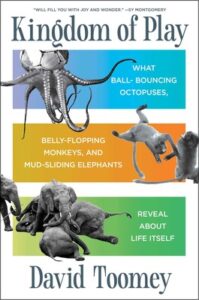
“She’s Bouncing the Ball!” On the Uncanny Way Octopuses Play
David Toomey on the Intelligent and Curious Nature of Our Favorite Cephalopods
One day in 1997, psychology professor Jennifer Mather answered her phone to hear the excited voice of Roland Anderson, her collaborator in a rather unusual study of animal behavior. “She’s bouncing the ball!” He was speaking in figurative terms, but ones he knew Mather would understand. The “she” was an octopus perhaps two or three years old, swimming in a tank at the Seattle Aquarium. The “ball” was an Extra Strength Tylenol bottle weighted to float just beneath the surface. And the “bouncing” wasn’t exactly bouncing.
Octopuses have an exhalant funnel, a siphon near the side of the head, through which they can jet water. The octopus had held the bottle with her arms and let it go; she then aimed her funnel at it and released a jet of water in its direction, sending it to the other end of the aquarium, where the water flow returned it to her. She was doing it again and again. After Anderson had seen her perform the feat sixteen times, he decided it was time to call Mather.
Real, empirical evidence of octopus play would be a finding of some consequence.
Jennifer Mather is a preeminent researcher on octopus behavior, and a peripatetic academic, having done research in many places. During a dive in the waters off Bermuda, she noticed an interesting behavior of the common Atlantic octopus known as Octopus vulgaris. It found a small rock, tucked it under its arms, and placed it near its den. The octopus then retrieved another rock. And another and another.
It slid into the den and pulled all the rocks behind it, effectively barring the entrance from intruders before going to sleep. Octopuses had been known to demonstrate rudimentary intelligence, but Mather recognized this as something far more sophisticated. Since the octopus was not reacting to any existing threat, but rather in anticipation of one, it had demonstrated foresight and planning.
Like Mather, Roland Anderson was a scuba diver. His preferred environs were the rather colder waters of Puget Sound, where he was known to dive even at night and in the rain, once just to look for small Octopus rubescens that had found homes in beer bottles resting on the ocean floor. Anderson’s vocation and avocation were happily one. Professionally, he was a marine biologist employed at the Seattle Aquarium, where his specialties included the natural history and behavior of octopuses.
While performing his rounds one morning, Anderson discovered that one of the aquarium’s giant Pacific octopuses had dug up the gravel from the bottom of its tank, bitten through the nylon cable ties that attached the filter to the tank, and torn the filter into small pieces. Anderson did not understand the octopus’s motivation for destroying the filter, but he did know that its actions, like those of Mather’s octopus, were methodical, requiring both foresight and planning.
Mather and Anderson first met at a conference and found they shared a fascination for a certain order of cephalopod mollusk as well as a suspicion that there was more going on in their minds than many believed. They wondered whether octopuses played. The creatures had a penchant for manipulating objects, which indicated both intelligence and curiosity. The step from manipulating objects to playing with them might seem small, and in the terms of behavior, it would be. But in terms of taxonomy, it would be a giant step—or rather a leap—across whole phyla. Mammals and birds, long recognized as playful, are members of the phylum Chordata. But octopuses are cephalopods, of the phylum Mollusca.
Early in the third century CE, Roman natural historian Claudius Aelianus wrote, “Mischief and craft are plainly seen to be the characteristics of this creature.” In the years since, they’ve become no less mischievous and crafty, as attested by researchers whose instruments they are known to take apart. When marine biologist Jean Boal and her colleagues noted octopuses’ “relative intractability as experimental subjects,” they might have been speaking for many a weary cephalopod researcher.
Octopus behavior certainly seems playful. Yet no one had attempted to demonstrate that it was play or to prove, under experimental controls, that octopuses played. Real, empirical evidence of octopus play would be a finding of some consequence. It would mean that the behavior had evolved in two phyla that had diverged 670 million years ago.
In the 1990s many experiments gauged octopus intelligence and curiosity. Most had been of the rudimentary, stimulus-response sort. An object, say a mussel shell, would be dropped into an octopus’s tank. An octopus seeking food would explore the shell, use its arms to push, prod, and turn it over. When it found no food and nothing more worth investigating, the octopus would lose interest in the shell and leave it alone.
If the same experiment was performed with an especially curious octopus, the response might be different. When the shell first appeared, the octopus would explore it. The feel of striations on the shell’s surface might stimulate further exploration, and eventually the octopus would find the shell’s inner concavity. Its smooth surface, an especially intriguing contrast to the striations, might stimulate more study. So it would go, a recurring cycle of stimulus and investigation, with each stimulus prompting further investigation and each investigation uncovering another stimulus. The cycle would greatly extend the period of investigation, with a curious octopus taking far longer to explore the shell before losing interest.
Since the octopus was not reacting to any existing threat, but rather in anticipation of one, it had demonstrated foresight and planning.
Mather and Anderson thought that in that slide from exploration to habituation some behavior might justifiably be called play. To distinguish play from exploration would be difficult, but they designed an experiment that they hoped might accomplish just that. They chose as their test subject the giant Pacific octopus (Enteroctopus dofleini), a species well adapted to the cold, oxygen-rich water of the coastal North Pacific. It’s the largest octopus species; an adult may weigh more than 110 pounds and live for four or five years. The individuals to be tested, five males and three females, were somewhat lighter and younger— “subadults” two to three years old that weighed between two and twenty pounds.
Mather and Anderson knew that they might prompt play by giving the octopuses something interesting to investigate. They decided upon four plastic pill bottles weighted to just above neutral buoyancy. Octopuses have limited color vision but good vision for light intensity, so two bottles were painted white and two painted black. And since octopuses are sensitive to texture, one white and one black bottle were given smooth surfaces, the other two rough ones. Each octopus was allowed ten opportunities or “trials” lasting thirty minutes, which Mather and Anderson deemed sufficient time for the octopuses either to engage with the bottles or to demonstrate no interest in them.
All eight octopuses made contact with the bottles in some fashion, either by pressing a sucker against a bottle, curling an arm around it, or using an arm to press the bottle against its mouth. Mather and Anderson judged these actions to be investigation. Two octopuses, though, engaged with the bottles in a manner that looked like play. Octopus 8 used its funnel to create a jet of water that pushed a bottle to the wall of the aquarium and back. Octopus 7 issued a water jet that caused the bottle to travel “in a circular path…around the aquarium periphery,” prompting Anderson’s phone call.
Octopuses had been known to use exhalant funnels to propel themselves, to clean detritus at the mouth of their dens, and to push away irritations such as scavenging fish and stinging sea anemones. In captivity, octopuses often use the funnels to repel a food they regard with some contempt—say frozen shrimp. But as far as anyone knew, they had never been used like this. Octopuses 7 and 8 were not pushing the bottle away; on the contrary, they had found an interesting way to make it return.
Mather has addressed all manner of audiences—from professional animal behaviorists to schoolchildren—hundreds of times, but she speaks with such deliberation that you might think that as she voices each word, she considers it anew. When she later adopted Anderson’s metaphor, she was careful to explain it. “That’s just exactly the kind of thing we do when we bounce a ball,” she told an interviewer. “When you bounce a ball, you are not trying to get rid of the ball, you are trying to figure out what you can do with the ball.”
__________________________________

Excerpted from Kingdom of Play: What Ball-Bouncing Octopuses, Belly-Flopping Monkeys, and Mud-Sliding Elephants Reveal about Life Itself by David Toomey. Copyright © 2024 by David Toomey. Excerpted with permission by Scribner, a division of Simon & Schuster, Inc.
David Toomey
David Toomey is a Professor of English at the University of Massachusetts, Amherst, where he teaches courses in writing and in the history of science. He is the author of several books of nonfiction, including Weird Life and The New Time Travelers. In his lifetime he has known and played with a great many animals, both human and non-human.



















